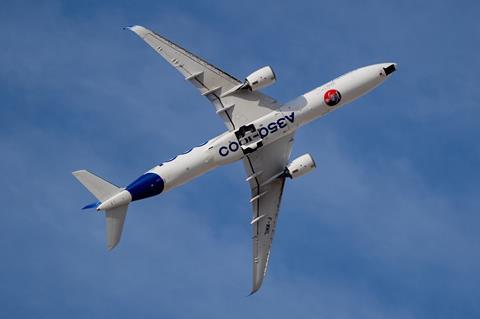Emirates believes the Airbus A350-1000 would fit into the carrier’s fleet, but it will not be considered until Rolls-Royce is able to offer greater engine durability for the airline’s specific conditions and operations.
The A350-1000 is powered by the Rolls-Royce Trent XWB-97, a higher-thrust version of the XWB-84 used on the -900, which Emirates will introduce next year.
While the airline’s president, Tim Clark, says the XWB-84 engines are “good to go”, he says that an A350-1000 acquisition will not materialise until he is satisfied with the type’s powerplant.
“Clearly the [XWB-97] engine isn’t doing what we want it to do,” he said, speaking during a briefing at the Dubai air show. “Until it does we won’t be ordering.”
He says the XWB-97 engine needs to “stay on wing” for a minimum of 2,000-2,500 cycles. “And if can do that, at a maintenance cost per hour that is OK with us, that would be all right. But it’s not doing that at the moment,” he claims.
Clark was highly critical when Airbus opted to redesign the A350-1000 in 2011, partly over the manner in which it took place but also because he believed the improvements were not sufficient. Although the engine thrust was hiked from 93,000lb to 97,000lb, Clark had argued that this came at the expense of commonality.
The carrier subsequently cancelled its order for 70 A350s, of which 20 were -1000s.
Clark says that, at the time of the redesign, Airbus was “all over the show as to where they wanted it to be”. But the -1000 has since undergone incremental enhancements, and the aircraft will suit Emirates’ needs “when the engine’s solved”, he states.
“It’s now an aeroplane which we think we could easily fit into the fleet, if the engines worked. Quite a good one, actually,” he adds.
But Clark points out that Emirates operates its fleet with “very high” utilisation. “We whack these aeroplanes around the skies, full up, all the time,” he says.

Emirates operates in a region which is “problematical” given the high temperatures and dust levels, he says, claiming that if the carrier took the XWB-97 in its current state, it would “probably end up with less than a quarter of the cycles on wing”.
“Which would mean maintenance costs per hour would more than quadruple, because of all the consequential cost we would face. In addition to that, we’d have to have a large number of spare engines at $20 million a pop.”
Clark says the carrier could potentially take 35-50 A350-1000s. “If the engine was doing what we want it to do – and Rolls-Royce knows what we want it to do, and so does Airbus – then it would re-enter the mix of assessment for our fleet plan.”
Rolls-Royce did not return FlightGlobal’s request for comment during the show, but the company’s civil aerospace president, Rob Watson, had stated in Dahlewitz, ahead of this year’s Paris air show, that technologies developed for its UltraFan programme could enhance current engine durability and time-on-wing.
“We are really happy with the performance of the XWB family of engines but like all engine OEMs across the industry when we are operating in hot and sandy conditions there is an impact on durability,” said Watson at the time.
Rolls-Royce outlined plans for harsh-environment simulation tests using the high-temperature turbine technology demonstrator, which is based on the XWB-97 engine.
Emirates ordered more Boeing 777X twinjets at the Dubai show, including the General Electric GE9X-powered 777-8 which Clark says is “right on top of the A350-1000 now – so it’s game on”.
He argues that the A350-1000 is “probably 10,000lb too light on thrust” and Emirates would prefer that it offered 107,000lb to give the twinjet more lift and power.
“I do think she’s under-spec for what the aircraft could do,” he says.
Clark refers to Australian operator Qantas’s decision to take the type for its ‘Project Sunrise’ routes from London to Sydney.
“If you look at Sunrise coming, that’s going to tax the engine, but the hours per cycle are very long,” he says. “It’s really going to be under pressure in the take-off and climb profile, she’ll be running at pretty high thrust right through to top of climb – and that’s quite a long one with that kind of load.”
Airbus chief commercial officer Christian Scherer, speaking shortly after EgyptAir disclosed an agreement for 10 A350-900s – powered by XWB-84 engines – described the Trent XWB as “formidable”, and insisted: “It’s a perfectly fine engine operated by many customers around the world.”


























